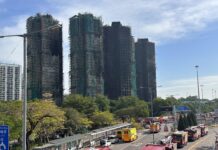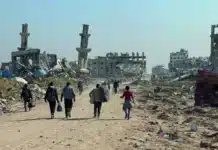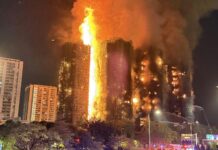The International Committee of ISA met on Thursday 26 June. The main discussion was on World Perspectives with focus on the Middle East. The text below is based on the introduction to that discussion, given by Per-Åke Westerlund from ISA’s International Political Committee.
Of course, Donald Trump’s presidency still dominates world perspectives. He is a symbol of capitalism in the 2020s and even more so the second half of the 2020s, as we approach another tumultuous ‘30s’. His reactionary ideas and repression are also part of the period. So are his prominent Bonapartist traits, including how he uses his position for obscene personal enrichment. The repulsive flattering received at the NATO summit this week was almost like one of the meetings of his own administration.
Fordow bombing
The last five months have seen US imperialism establishing a new global power structure. The bombs over dropped Fordow and Natanz last Saturday were the most capable weapons of destruction that exist, second only to nuclear bombs. Trump also made a comparison with the bombs over Hiroshima and Nagasaki 80 years ago. As Marxists stated in 1945, these mass killings were not directed at Japan, but at the Soviet Union. It did not create peace—Korea, Vietnam and colonial liberation wars all quickly followed—and it was in the context of a unique post-war boom.
The 12 “bunker buster” bombs dropped on Iran, each of them weighing over 13 tonnes, were a warning also to China, Russia and their bloc. ISA has a unique understanding of this because of our analysis of the conflict between US and Chinese imperialism as the defining trait of this era.
Iran has been a member of BRICS since last year, and there is clearly no common response from that bloc, which some predicted to be a challenger of US imperialism.
The US stands for nearly 40 percent of all military spending globally, close to one trillion dollars. Only 20 countries have a GDP of one trillion or more. The bombing was also directed to US allies before the NATO summit as a show of strength, for the rest to understand their subordinate roles. The NATO decision to spend 5% of GDP on ‘defence’ means in practice that 10–20% of state budgets will go to the military.
Having so far failed to use his tariffs to establish American power, it is now being demonstrated militarily. This followed Israel’s attacks that killed close to 1,000 and wounded 4,000. In Israel, 29 were killed by Iranian attacks and over 3,000 needed hospital treatment.
No peace, changed balance of power
Peace is declared, but there is of course no peace and stability. Trump’s “12 day war”, a reference to the 6-day war in 1967, is in reality a 20-month war since 7 October 2023 with a much longer history. The genocide in Gaza continues, with 50 to 100 individuals queuing for food killed every day by Israeli soldiers. The Israeli Army now controls over 80% of Gaza, with 2 million Palestinians living in famine regularly ordered to evacuate to ever more minimal areas. The West Bank is also an area which is witnessing ongoing ethnic cleansing. Israel has also established a permanent military presence in both Lebanon and Syria, and conducts regular attacks.
The last year has seen a major change in the balance of regional power in the Middle East in favour of the state of Israel. Iran has lost its “axis”, and its global allies cannot provide military support. While standing and campaigning against the war on Iran, ISA distinguishes itself from those on the left that support Iran and see something progressive in its military actions or even, as the regime itself promotes, celebrate some kind of Iranian victory. In reality, the retaliation from Iran was much weaker than everyone predicted.
We have many times referred to the hubris of Netanyahu and his extreme-right wing government. With the attack against Iran, this reached a peak. The need to get the US involved, with Trump pushing for Iran to “surrender” and pursuing his kind of ceasefire, meant that Netanyahu had to restrain himself at times. On Tuesday morning, after a call with Trump, he even had to order fighters already in the air to turn back.
Netanyahu’s targets
Of Netanyahu’s targets, he failed to win the regime change he has desired for so long. Netanyahu wants another Syria, a new regime that can handle internal opposition but is weak outside of its borders. The al-Sharaa government in Syria has turned West, including meeting Trump in Saudi Arabia, and has both Israeli and Turkish troops within its borders. Iran, however, is a different case. Trump therefore is aiming for the variant of the 1991 Iraq war, after which Saddam Hussein was left in power.
It also seems that Netanyahu failed in his target to destroy Iran’s nuclear capability and enrichment. Far from Trump’s statement that the facilities in Fordow were “totally obliterated”, the Pentagon’s security service, the DIA, says the bombing only delayed Iran’s ability to produce nuclear weapons by six months at most.
If the dictatorship in Iran now—not surprisingly—takes real steps towards nuclear weapons, both Israel and the US will attack again, stronger and harder. Tehran has already claimed its nuclear activities will continue and the International Atomic Energy Agency (IAEA) says 408 kilos of 60% enriched uranium is missing. Iran still has the capacity to proceed towards a bomb, experts said yesterday.
In comparison to Afghanistan and Iraq, US imperialism lacks forces on the ground. And even then, it did not result in the “democracies” the neocons spoke about. Military interventions and bombing campaigns, as in Afghanistan, ended up with the Taliban in power again. In the war of extermination on Gaza, Netanyahu does not even have an end plan.
Supporters of the bombing
What Netanyahu did achieve with the attack on Iran was to silence the so-called opposition parties in Israel, with some of them calling for even sharper attacks. He also silenced hypocritical Western governments, who at the G7 meeting in Canada praised Israel’s “right to defend itself” and warned about the threat to the world Iran represents.
Furthermore, he re-established his relationship with Trump, whose emphasis on talking to Iran now seems mostly to have been a smoke-screen. Iran could not at that stage have conceded and closed down its nuclear facilities, something Trump of course knew.
After Saturday’s bombing, Trump typically said “We worked as a team—like perhaps no team has ever worked before”. However, Trump’s anger 48 hours later, underlined that their interests are not identical and also showed who is the master in the relationship.
Trump officially joined the campaign when he thought it would be short and successful—thereby keeping his MAGA critics calm and hoping for the same among the regimes and masses in the Middle East.
Trump’s plans
Trump wants to move on with a settlement between Israel and the Saudi regime, addressing the future of the Palestinians in one way or another, but mainly establishing greater US power and control in the region. He wants the “Abraham accords” story to continue. The Gulf state regimes feared Iran’s retaliation and generally the response of their own masses, but now hope the worst is over.
Ceasefires are of course welcome for a population hammered by bombs. But nothing is solved in the Middle East. US imperialism’s closest allies are Netanyahu’s government, without majority support, and dictatorships repressing protests and movements from below in a similar way to the Iranian regime. And while Trump is stressing their investment in the US, China is still Saudi Arabia’s largest trading partner.
Revolutions in the Middle East
As Marxists, we point to the history of revolutions and revolts in the region — the latest in 2010–11 with the working class playing a decisive role in both Egypt and Tunisia. And the almost constant movements in Iran, from the student movement in 1999, the revolutionary wave in 2009 and Women Life Freedom in 2022, with young women at the forefront along with oppressed nationalities. Strikes in Iran are regular, most recently with the major truck drivers strikes covering the entire country. However, we also point to the need for organisation, centralising and co-ordinating the struggle and a clear program. The lessons of the revolutions 15 years ago must be studied.
There are some on the left that argue that the working class in Israel will never rise, while others say the regime in Iran can never be overthrown. In 1939, Trotsky wrote “World reaction has unquestionably assumed monstrous proportions nowadays. …Fascism may perhaps seize upon the whole of Europe.” He argued strongly, based on historical experience, that “… thereby it has prepared the soil for the greatest revolutionary crisis. (…) It is absurd, unscientific, unhistorical to think that reaction will continue to unfold at the same gradual pace at which it has been accumulating hitherto. Reaction signifies this, that the social contradictions are mechanically suppressed. At a certain stage, an explosion is inevitable.”
We point at the effects of even limited strikes in Israel. In September last year at one of the peaks of the movements to end the war and free the hostages, the warmongering Histadrut leadership was forced to organise a de facto general strike. Despite it being supported even by some capitalists, it gave a glimpse of the strength of the working class. This spring, teachers and others have protested against wage cuts that have been implemented to pay for the war.
Representatives of capitalism
ISA long warned of Trump 2.0. We see both him and Netanyahu as representatives of the system, not just as mad individuals. We have understood the world has entered a new epoch, the previous wave of capitalist globalisation and neoliberal market dominance has to be replaced. This has created a deep political crisis for liberal and social democratic parties. They have all moved sharply to the right, and in practice are no different to traditional rightwing bourgeois parties, at NATO summits or when in government. This shift to the right has fed the growth of forces even further to the right, as we have seen this year in Portugal, Romania, Germany, Poland and elsewhere.
Trump wants to be seen as dictating events. Only two days ago, after being received like a king in Belgium for the NATO meeting, he seemed to doubt whether NATO countries should defend each other. And when he praised Iran for giving advance warning of its missiles fired at the US base in Qatar, he added that sanctions against China buying oil from Iran were to be lifted and expressed hope Beijing would buy a lot.
At the same time, he has completely failed in his promise about peace in Ukraine. He has conquered Ukrainian natural resources and attempted to rehabilitate Putin. And his description of Ukraine vs Russia and Israel vs Iran as children always fighting is the same. He wants to leave Ukraine as a European responsibility, but can’t fully step out.
Resistance to Trump
Of course, the main arena for Trump and the resistance against him, is the US itself. The latest day of protest was the largest ever in the US, with 5–10 million participating in demonstrations following the ICE raids in Los Angeles. ISA’s US section has made excellent interventions and initiatives that will be reported on at this meeting, campaigning for a one day national strike and predicting a summer of resistance.
Of utmost importance is our position pointing at the real threat from Trump, in contrast to the ultralefts, to argue against illusions in Democrats, courts or the constitution. We see the limitations and crisis of Trump, but the way to really fight is mass struggle with the working class at the head. Still in the beginning, with very promising openings for us.
The discussion which followed this introduction also covered the world economy, the state of the conflict between US and Chinese imperialism, the protest movement in the US, perspectives for Iran and for the war in Ukraine, new left wing developments, lessons of mass struggles and new left parties.




